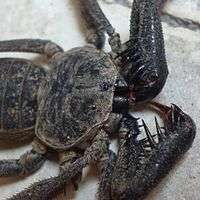Paraphrynus
Paraphrynus is a genus of whip spiders, also known as tailless whip scorpions (order Amblypygi), of the family Phrynidae. It is distributed from the southwestern United States to Central America, including several Caribbean islands. Most species are endemic to Mexico.
| Paraphrynus | |
|---|---|
.jpg) | |
| Paraphrynus mexicanus | |
| Scientific classification | |
| Kingdom: | |
| Phylum: | |
| Class: | |
| Order: | |
| Family: | |
| Genus: | Paraphrynus Moreno, 1940 |
Taxonomy

This genus can be told apart from Phrynus by observing the patella of the pedipalp, which in Phrynus has one small spine between the two largest, while Paraphrynus has two. It can be distinguished from Acantophrynus by its lack of spines in the frontal region of the carapace. The remaining member of the family Phrynidae, Heterophrynus, does not seem to be sympatric with any species of this genus.
There are about 18 species:[1]
- Paraphrynus aztecus (Pocock, 1894)
- Paraphrynus baeops (Mullinex, 1975)
- Paraphrynus carolynae Armas, 2012
- Paraphrynus chacmool (Rowland, 1973)
- Paraphrynus chiztun (Rowland, 1973)
- Paraphrynus cubensis Quintero, 1983
- Paraphrynus emaciatus Mullinex, 1975
- Paraphrynus grubbsi Cokendolpher and Sissom, 2001
- Paraphrynus laevifrons (Pocock, 1894)
- Paraphrynus leptus Mullinex, 1975
- Paraphrynus macrops (Pocock, 1894)
- Paraphrynus maya Armas, Trujillo & Agreda 2017
- Paraphrynus mexicanus (Bilimek, 1867)
- Paraphrynus olmeca Armas & Trujillo 2018
- Paraphrynus pococki Mullinex, 1975
- Paraphrynus raptator (Pocock, 1902)
- Paraphrynus reddelli Mullinex, 1979
- Paraphrynus robustus (Franganillo, 1931)
- Paraphrynus velmae Mullinex, 1975
- Paraphrynus viridiceps (Pocock, 1894)
- Paraphrynus williamsi Moreno, 1940
Biology
Like other Amblypygi, the species in this genus are nocturnal predators that dwell in moist microenviornments. Some species are troglophiles and some are true troglobites.[2] They feed upon insects and other arachnids. Paraphrynus have flattened bodies that are approximately 3/8” (3-11 mm) long, with spiny pedipalps and antennae-like legs referred to as antenniform legs. The front, first pair of legs are long filamentous or whip-like tips, while the other 3 pairs of legs are positioned to the side, crablike. The longer front legs are sensory organs that are used to "feel" about and locate its prey, which they then ensnare with the spiny pedipalps.[3] Research conducted by biologists also found that the front legs of P. laevifronsis are used to navigate to their refuge prior to dawn, usually spending the night hunting for prey on the vertical surfaces of tree trunks in a neotropical environment.[4]
References
| Wikimedia Commons has media related to Paraphrynus. |
- Paraphrynus. Integrated Taxonomic Information System (ITIS)
- Cokendolpher, J. C. and W. D. Sissom. (2001). A new troglobitic Paraphrynus from Oaxaca, Mexico (Amblypygi, Phrynidae). Texas Memorial Museum, Speleological Monographs 5 17-23.
- Iowa State University. “Species Paraphrynus carolynae- Tail-less Whip Scorpion”. Retrieved 25 October 2018.
- Bingman, V.P.; Graving, J.M.; Hebets, E.A.; Wiegmann, D.D. (2017). “Importance of the antenniform legs, but not vision, for homing by the neotropical whip spider Paraphrynus laevifrons”. Journal of Experimental Biology. 220: 885-890. Doi: 10.1242/jeb.149823